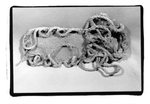
A Modern Sandal Company Is Haunted By The Soles Of An Ancient People.
By Leo Banks
FLAGSTAFF, ARIZONA--Enter the back-country around this
picturesque mountain town and see the bottled-water and fanny-pack
crowd spending summer vacations crawling through canyons, just
as the ancients did--except for the high-tech running shoes.
But wait. Lagging behind the group is a fellow in black socks
and sandals, an obvious tinhorn, probably from New Jersey.
Sandals in canyon country? Truth is, they might be the best way
to traverse the mountains, riverbeds and rock-strewn deserts
of southern Utah and northern Arizona.
 Recent work by archaeologists reveals that Native Americans from
1,400 years ago wore a sandal with a sole so well-designed they're
the technological equivalent of modern-day Nikes and Adidas. Two
hundred of these yucca sandals, finely woven by artisans using
22 different textile techniques, were discovered in 1930-31 by
Earl Morris, an archaeologist for the Carnegie Institute, and
his wife, Ann.
Recent work by archaeologists reveals that Native Americans from
1,400 years ago wore a sandal with a sole so well-designed they're
the technological equivalent of modern-day Nikes and Adidas. Two
hundred of these yucca sandals, finely woven by artisans using
22 different textile techniques, were discovered in 1930-31 by
Earl Morris, an archaeologist for the Carnegie Institute, and
his wife, Ann.
For much of the next half century, they languished in a drawer
at Arizona State Museum in Tucson--until Kelley Hays-Gilpin, an
archaeologist at Northern Arizona University, studied the so-called
Prayer Rock sandal collection as part of her dissertation. That
project led to a collaboration with Elizabeth Ann Morris--daughter
of the original discoverers--and a third archaeologist, Ann Cordy
Deegan, on a book, Prehistoric Sandals from Northeastern Arizona.
Hays-Gilpin and her co-authors studied the safety literature
used by modern shoemakers and found that the Prayer Rock sandals,
most likely made by the Anasazi, forerunners of present-day Hopi
and Zuni people, measure up quite favorably.
Their soles have the perfect tread depth for gripping and the
edges point out so that water squirts away, as it does with modern
tires. The soles also have multi-directional ridges to reduce
slipping, and the yucca gives them flexibility.
"The Anasazi had deer, badger and elk to kill so they could
easily have relied on leather moccasins, but they didn't,"
says Morris, a retired Colorado archaeologist. "In a country
of cactus spines and sharp rocks, they mostly wore these open
sandals. They must've known something we don't."
Enter Mark Thatcher, who put himself through NAU in the late1970s
as a guide on the Colorado River through the Grand Canyon. The
experience led to an idea, which led to a company and a product
that's currently a craze throughout the West and beyond--the Teva
sports sandal.
As he led tourists through the Canyon, often hiking through water,
Thatcher watched his guests remove their running shoes, swim across
a pool, then stop to lace their shoes back on before continuing.
That and other experiences convinced him that the best way to
traverse that terrain was in amphibious sandals.
 Thatcher, now 43, started his company in 1984 and soon discovered
great enthusiasm for his product beyond the amphibious market.
Marathon runners and athletes of all kinds have used Teva sandals.
Thatcher, now 43, started his company in 1984 and soon discovered
great enthusiasm for his product beyond the amphibious market.
Marathon runners and athletes of all kinds have used Teva sandals.
"I can make a case that anything you can do in an athletic
shoe, you can do as well in a well-designed sandal," says
the Flagstaff-based Thatcher. "The foot functions better
when it isn't locked in tight, like in a running shoe." As
for getting jabbed by a sharp plants and rocks, he says socks
provide as much protection as a strip of nylon.
But it was only after designing his own sandal, and being in
business for several years, that Thatcher became aware of the
Anasazi sandals.
"When I started out, I knew nothing of the Anasazi,"
says Thatcher. "But the environment of the Grand Canyon had
taught me the same thing it taught them. I was having an Anasazi
experience and didn't know it." Since then, he has studied
Anasazi sandals, and their design has inspired changes in his
own product.
Teva's worldwide distribution and sales are spreading the word
on the wisdom of these Native Americans. In 1995-1996, the University
of Utah in Salt Lake City hosted an exhibit of Anasazi sandals,
sponsored in part by the Teva company. Its opening was blessed
by a Navajo medicine man.
"Athletic sandal design in America has been lost since the
Anasazi," says Thatcher. "But it's coming back. We're
getting smarter."
Something else the ancients knew, a fact of human nature as deep
and everlasting as any other. "People just love to wiggle
their toes," says Thatcher.

|





